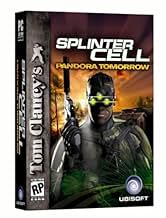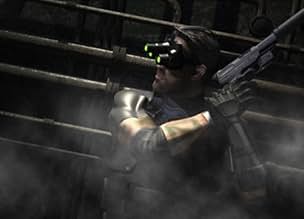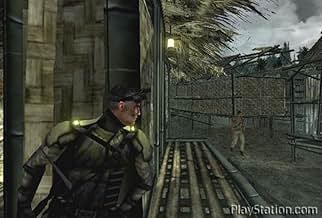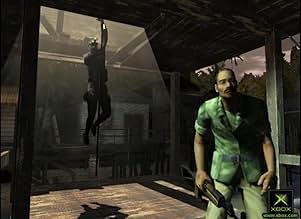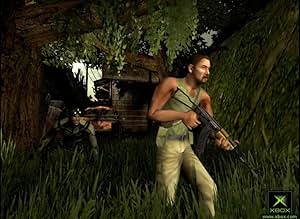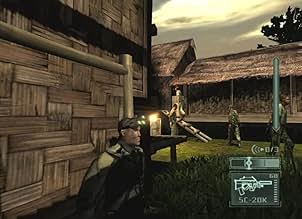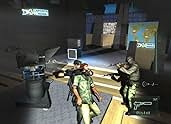PUNTUACIÓN EN IMDb
8,1/10
2,2 mil
TU PUNTUACIÓN
Añade un argumento en tu idiomaStealth-mission expert Sam Fisher is sent after a terrorist, who leads an operation involving setting up bombs with the smallpox virus on US territory.Stealth-mission expert Sam Fisher is sent after a terrorist, who leads an operation involving setting up bombs with the smallpox virus on US territory.Stealth-mission expert Sam Fisher is sent after a terrorist, who leads an operation involving setting up bombs with the smallpox virus on US territory.
- Dirección
- Guión
- Reparto principal
- Nominado a 1 premio BAFTA
- 3 nominaciones en total
Bill Dunn
- Additional Voices
- (voz)
- (as William Dunn)
Stephen Croce
- Additional Voices
- (voz)
- (as Steven Croce)
Christopher Mack
- Additional Voices
- (voz)
- (as Chris Mack)
Dana Burns Westburg
- Additional Voices
- (voz)
- (as Dana Burns Westberg)
Leslie Palanker
- Additional Voices
- (voz)
- (as Leslie Lanker)
Reseñas destacadas
I will agree that the environments and the AI were incredible and the graphics overall were second to none, but I feel that the single player mode was sacrificed in order to bring the multi-player mode to life. The game was far too short and I didn't feel the profile of Sadono was robust enough. In the original, you actually felt hate and anger towards Nickoladze because of the detail and time spent to develop that character. I am not saying that Pandora Tomorrow was bad, not at all. I am just hoping that they go back to formula with Chaos Theory and develop a new era for gaming, much like was done when Splinter Cell 1 was first released. I gave Pandora a 4 out of 5.
If you are thinking this is going to be the same as the original, you're wrong. Sure, you're still Sam Fisher, an expert spy who can infiltrate a factory without anyone know he's there. But there is one really big change. You're outdoors. Yep, you heard me. And boy do they make it look good. The environments are lush and beautiful. The bushes sway in the wind as you move past them. You still have to deal with industrial settings though. But even they can't match the beauty of the outdoors. Okay, enough of that. Lets go to gameplay. The AI is 100x approved over the original. Now enemies can grab a civilian and hold them hostage. Also, if they detect you, they don't have to run over to the alarm. Just one push of a button on their uniform, and that little baby will start sounding. And if you sound one alarm, every enemy will have a bullet proof vest on. Two alarms a helmet. Three alarms, I don't know, but it's not good. Which leads me to another thing. The game is hard. Really hard. It's impossible to beat a level on the first try. Even experts of the original will have a hard time getting through this. But even though it's hard, it's really short. There's only eight levels(the original had ten). But one thing will get you busy after you're done... The multiplayer. Here's how it is. A team of mercenaries try to get the spy. That's it. But it's fun trying to hunt down an almost invisible person. And it's fun killing unsuspecting mercenaries while you're almost invisible. So let me sum it up. The graphics are incredible, the AI is seamless, and the multiplayer is fun. Pandora Tomorrow gets a 5 out of 5.
9 out of 10 - The Sequel That Elevated the Shadows
Pandora Tomorrow wasn't just a follow-up to the original Splinter Cell - it was a declaration that stealth had evolved. Released in 2004, this second chapter in Sam Fisher's saga didn't radically overhaul the formula but instead refined and polished it, delivering one of the most atmospherically rich, mechanically tight stealth games of its generation.
Gameplay: Evolution Over Revolution
Mechanically, Pandora Tomorrow stayed true to the deliberate, tension-filled stealth of the original. But it tightened the experience in just the right places. Movement was more fluid, the AI was sharper, and the addition of mechanics like "SWAT turns" and the ability to whistle or knock to lure enemies added layers of tactical control. You felt like a true operative - not because of brute force, but because you could out-think everyone in the room.
The environments pushed variety too. From shadowy jungle encampments in East Timor to ultra-secure American embassies, every level demanded a different approach. Light and sound meters returned, reminding you constantly: the environment is a weapon... but it can also betray you.
Story: Global Stakes, Tightly Told
The story introduced Suhadi Sadono - a charismatic and ruthless insurgent leader who executes a chilling biological threat codenamed "Pandora Tomorrow." The concept? Sleeper cells across the U. S. will release a deadly virus if he's killed. It's a brilliant narrative device that gives every mission tension: the line between success and global catastrophe is razor-thin.
Sam's mission takes him from the U. S. to Indonesia, Jerusalem, and Paris - always grounded in real-world political tension. While Chaos Theory might have had more edge, Pandora Tomorrow brought a cinematic seriousness that made each mission feel critical.
Multiplayer: The Game-Changer
Where Pandora Tomorrow really flipped the script was with its Spies vs. Mercs multiplayer mode - one of the most groundbreaking additions to stealth gaming, period. Two stealthy spies vs. Two heavily armed mercenaries. Asymmetrical. Tense. Strategic. This wasn't just a side mode - it was a revolution.
Spies relied on agility and shadows. Mercs relied on vision, firepower, and traps. The cat-and-mouse gameplay created stories of its own - and inspired an entire subgenre of multiplayer.
Voice Work and Atmosphere
Michael Ironside once again anchors the experience as Sam Fisher - his calm, sardonic delivery giving weight to every moment. Lambert, Grim, and the rest of the team ground the story with CIA-style precision, and the environments - whether it's a mosque in Jerusalem or the thick undergrowth of Indonesia - are dripping with atmosphere.
The soundtrack, lighting, and sound design all combine to pull you into the shadows. You don't just play Pandora Tomorrow - you inhabit it.
Why 9, Not 10?
Difficulty Spikes: Some missions leaned into trial-and-error a bit too much.
Linear Design: Compared to Chaos Theory, some paths felt too restrictive.
Multiplayer Support: While revolutionary, early online issues hampered some players from experiencing the full depth of Spies vs. Mercs.
Still, these don't overshadow what the game accomplished.
Pandora Tomorrow wasn't just a follow-up to the original Splinter Cell - it was a declaration that stealth had evolved. Released in 2004, this second chapter in Sam Fisher's saga didn't radically overhaul the formula but instead refined and polished it, delivering one of the most atmospherically rich, mechanically tight stealth games of its generation.
Gameplay: Evolution Over Revolution
Mechanically, Pandora Tomorrow stayed true to the deliberate, tension-filled stealth of the original. But it tightened the experience in just the right places. Movement was more fluid, the AI was sharper, and the addition of mechanics like "SWAT turns" and the ability to whistle or knock to lure enemies added layers of tactical control. You felt like a true operative - not because of brute force, but because you could out-think everyone in the room.
The environments pushed variety too. From shadowy jungle encampments in East Timor to ultra-secure American embassies, every level demanded a different approach. Light and sound meters returned, reminding you constantly: the environment is a weapon... but it can also betray you.
Story: Global Stakes, Tightly Told
The story introduced Suhadi Sadono - a charismatic and ruthless insurgent leader who executes a chilling biological threat codenamed "Pandora Tomorrow." The concept? Sleeper cells across the U. S. will release a deadly virus if he's killed. It's a brilliant narrative device that gives every mission tension: the line between success and global catastrophe is razor-thin.
Sam's mission takes him from the U. S. to Indonesia, Jerusalem, and Paris - always grounded in real-world political tension. While Chaos Theory might have had more edge, Pandora Tomorrow brought a cinematic seriousness that made each mission feel critical.
Multiplayer: The Game-Changer
Where Pandora Tomorrow really flipped the script was with its Spies vs. Mercs multiplayer mode - one of the most groundbreaking additions to stealth gaming, period. Two stealthy spies vs. Two heavily armed mercenaries. Asymmetrical. Tense. Strategic. This wasn't just a side mode - it was a revolution.
Spies relied on agility and shadows. Mercs relied on vision, firepower, and traps. The cat-and-mouse gameplay created stories of its own - and inspired an entire subgenre of multiplayer.
Voice Work and Atmosphere
Michael Ironside once again anchors the experience as Sam Fisher - his calm, sardonic delivery giving weight to every moment. Lambert, Grim, and the rest of the team ground the story with CIA-style precision, and the environments - whether it's a mosque in Jerusalem or the thick undergrowth of Indonesia - are dripping with atmosphere.
The soundtrack, lighting, and sound design all combine to pull you into the shadows. You don't just play Pandora Tomorrow - you inhabit it.
Why 9, Not 10?
Difficulty Spikes: Some missions leaned into trial-and-error a bit too much.
Linear Design: Compared to Chaos Theory, some paths felt too restrictive.
Multiplayer Support: While revolutionary, early online issues hampered some players from experiencing the full depth of Spies vs. Mercs.
Still, these don't overshadow what the game accomplished.
When I first played this game I loved it, most people think it has 9 missions when really it has only 8. Also people think this is the hardest one out of the Splinter Cell series, I haven't played the first one but I have played this, Chaos Theory and Double Agent and I find this the most easiest one out of the three. I'm on the last mission on Pandora Tomorrow, Double Agent I'm on the 5th or 6th mission and on Chaos Theory I only got as far as the 3rd mission. Chaos Theory is hardest in my opinion. This game had good graphics, very lush and beautiful almost making it real. The levels of the game are also designed so that you have to be stealthy. Some levels lethal attacks are allowed, most levels only non-lethal attacks are your option. 8/10 is my rating for this game.
Originally, I didn't like the original Splinter Cell, but it kinda grew on me, and it's now one of my favourite games. However, this second instalment fails to live up to the standards set by it's predecessor, despite adding some shiny new features.
When Ubisoft made the original, I don't think they thought it would turn out to be the acclaimed hit that it was, so they farmed out programming duties to a third party software house in China. However, once they realised there was money to made, they took this sequel in-house, and the entire programming effort was done at it's French HQ. And what a great job they did of botching up the efforts of the original Chinese team.
Fisher (again excellently voiced by Hollywood uber baddie Michael Ironside, and ably assisted by Mr Velvet Tonsils; Dennis Haysbert from "24") now has new moves and gadgets to his repertoire, such as:-
A red laser dot for his pistol The ability to whistle and attract guards The "Swat turn" (whilst peeking around a corner) The "half split jump" (replaces the multi-jump of the original to reach high places)
The game also features:- Online Multiplayer (apparently it IS excellent, if you have online capability)
And it must be said, the graphics are the best ever seen on the PS2, absolutely beautiful use of light, water effects, and that foliage ! Wow !
However, the main problem with the game is that it was originally designed to run solely on the more powerful Xbox, and so has had to be "dumbed down" for Sony's red-headed stepchild. Whereas the Xbox could cope with 4 or more NPC's in a room, the PS2 has to make do with two. Whereas on the Xbox, ALL light sources were breakable, on the PS2 they are not. So at many points in the game you are in these huge, yet empty environments with minimal opposition. It's not really bad programming, it's just that this game was designed for Xbox, and it shows.
Sounds easy huh ? However, take away the breakable light sources and it becomes stupidly hard sometimes. Coupled with moronic AI Sam's Whistle feature; you stand one side of an open doorway and whistle at the NPC standing feet away on the other side he doesn't hear it ! Stand just inside the doorway, whistle, and he does !! Grrrrrr !!
Where Mr Frenchy has messed up, is by tinkering with elements of the game that were not broken. The Meditkits from the original have been replaced by strategically placed wall mounted "Health Dispensers". These have an accompanying and tiresome animation when you use them, which is extremely annoying in an NPC walks around the corner and shoots you whilst the animation is playing.
Also the randomness of the left analogue stick for the lockpick has been modified so that the "sweet spot" is in the same place each time ! And don't mention the savepoints !! They are SO frequent ! And SO annoying !! The original just had checkpoints, but this time you are invited to save the game at a checkpoint, which results in 4 to 5 confirmation boxes coming up, and then the checkpoint notification STILL comes up and freezes gameplay for 5 seconds ! The game save is only a tiny 91k, but it seems to take much longer.
Also some familiar controller keys have been changed, reload is now longer L2, it is X (the manual doesn't state this !), Triangle now does things that circle used to do and vice versa. Sam doesn't slide down ladders on a circle press, and you have to suffer the tedium of climbing down them.
However, on a positive note, Sam CAN now open doors whilst carrying a body. Hooray !
What about the "story". Hmmmm, Pandora Tomorrow abandons the building interiors of the original, firstly for the jungle, as you track down Sadono the Indonesian rebel with a taste for releasing the smallpox virus. And also you get to travel to Jerusalem and Paris the mission on TOP of a 200mph Eurostar train will make your fingers sweat ! Especially when Sam has to crawl under the train, and along the side of the carriages !
However, not being given enough info in your briefings often poses a problem, resulting in mission failures and restarts as you attack someone you apparently weren't supposed to. Quite often the game seems to abandon the premise of stealth altogether, forcing you into fire fights with the enemy. As your gun's aiming reticule moves at the pace of Iranian foreign policy you are often only an asthmatic's breath away from a body bag.
If you don't own a Splinter Cell game, then buy the original, at least that one was designed for the PS2, or wait for the third instalment which is due out anytime soon surely it must be better than this one ?
When Ubisoft made the original, I don't think they thought it would turn out to be the acclaimed hit that it was, so they farmed out programming duties to a third party software house in China. However, once they realised there was money to made, they took this sequel in-house, and the entire programming effort was done at it's French HQ. And what a great job they did of botching up the efforts of the original Chinese team.
Fisher (again excellently voiced by Hollywood uber baddie Michael Ironside, and ably assisted by Mr Velvet Tonsils; Dennis Haysbert from "24") now has new moves and gadgets to his repertoire, such as:-
A red laser dot for his pistol The ability to whistle and attract guards The "Swat turn" (whilst peeking around a corner) The "half split jump" (replaces the multi-jump of the original to reach high places)
The game also features:- Online Multiplayer (apparently it IS excellent, if you have online capability)
And it must be said, the graphics are the best ever seen on the PS2, absolutely beautiful use of light, water effects, and that foliage ! Wow !
However, the main problem with the game is that it was originally designed to run solely on the more powerful Xbox, and so has had to be "dumbed down" for Sony's red-headed stepchild. Whereas the Xbox could cope with 4 or more NPC's in a room, the PS2 has to make do with two. Whereas on the Xbox, ALL light sources were breakable, on the PS2 they are not. So at many points in the game you are in these huge, yet empty environments with minimal opposition. It's not really bad programming, it's just that this game was designed for Xbox, and it shows.
Sounds easy huh ? However, take away the breakable light sources and it becomes stupidly hard sometimes. Coupled with moronic AI Sam's Whistle feature; you stand one side of an open doorway and whistle at the NPC standing feet away on the other side he doesn't hear it ! Stand just inside the doorway, whistle, and he does !! Grrrrrr !!
Where Mr Frenchy has messed up, is by tinkering with elements of the game that were not broken. The Meditkits from the original have been replaced by strategically placed wall mounted "Health Dispensers". These have an accompanying and tiresome animation when you use them, which is extremely annoying in an NPC walks around the corner and shoots you whilst the animation is playing.
Also the randomness of the left analogue stick for the lockpick has been modified so that the "sweet spot" is in the same place each time ! And don't mention the savepoints !! They are SO frequent ! And SO annoying !! The original just had checkpoints, but this time you are invited to save the game at a checkpoint, which results in 4 to 5 confirmation boxes coming up, and then the checkpoint notification STILL comes up and freezes gameplay for 5 seconds ! The game save is only a tiny 91k, but it seems to take much longer.
Also some familiar controller keys have been changed, reload is now longer L2, it is X (the manual doesn't state this !), Triangle now does things that circle used to do and vice versa. Sam doesn't slide down ladders on a circle press, and you have to suffer the tedium of climbing down them.
However, on a positive note, Sam CAN now open doors whilst carrying a body. Hooray !
What about the "story". Hmmmm, Pandora Tomorrow abandons the building interiors of the original, firstly for the jungle, as you track down Sadono the Indonesian rebel with a taste for releasing the smallpox virus. And also you get to travel to Jerusalem and Paris the mission on TOP of a 200mph Eurostar train will make your fingers sweat ! Especially when Sam has to crawl under the train, and along the side of the carriages !
However, not being given enough info in your briefings often poses a problem, resulting in mission failures and restarts as you attack someone you apparently weren't supposed to. Quite often the game seems to abandon the premise of stealth altogether, forcing you into fire fights with the enemy. As your gun's aiming reticule moves at the pace of Iranian foreign policy you are often only an asthmatic's breath away from a body bag.
If you don't own a Splinter Cell game, then buy the original, at least that one was designed for the PS2, or wait for the third instalment which is due out anytime soon surely it must be better than this one ?
¿Sabías que...?
- CuriosidadesWhen Sam meets Shetland in the first level, Shetland asks who Sam is now working for. He guesses at SEALS and CIA. Sam replies, "No, staying anonymous," the acronym of which is NSA for whom Sam actually works.
- PifiasLambert can be seen getting a vaccination for small pox between mission 4 and 5. Lambert was born in 1961, meaning he attended primary school in the mid 1960's and early 1970's. At that time school children were routinely given several vaccination, including small pox, making the vaccination unnecessary and wasteful. Nearly all Americans over about 30 in 2006 would be immune to that virus.
- Citas
Coen: What do you think?
Sam Fisher: The world's small, nasty, and complicated. Everybody dies alone.
Coen: Hm. What do you think about Norman Soth?
Sam Fisher: Soth's small, nasty, and complicated. How he dies is up to him.
- ConexionesFeatured in Icons: Splinter Cell (2002)
Selecciones populares
Inicia sesión para calificar y añadir a tu lista para recibir recomendaciones personalizadas
Detalles
- Fecha de lanzamiento
- Países de origen
- Sitio oficial
- Idiomas
- Títulos en diferentes países
- Tom Clancy's Splinter Cell: Pandora Tomorrow
- Empresa productora
- Ver más compañías en los créditos en IMDbPro
- Color
- Mezcla de sonido
Contribuir a esta página
Sugerir un cambio o añadir el contenido que falta

